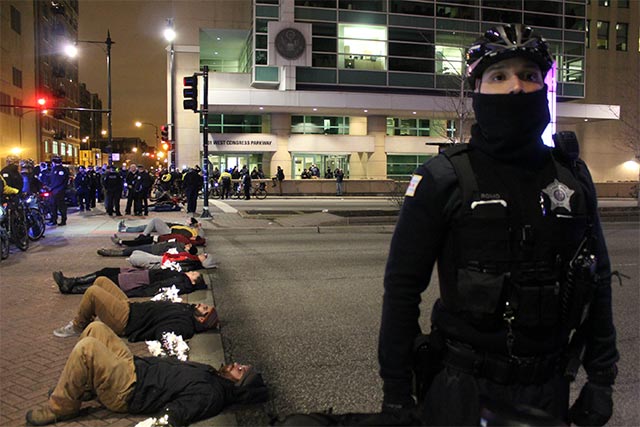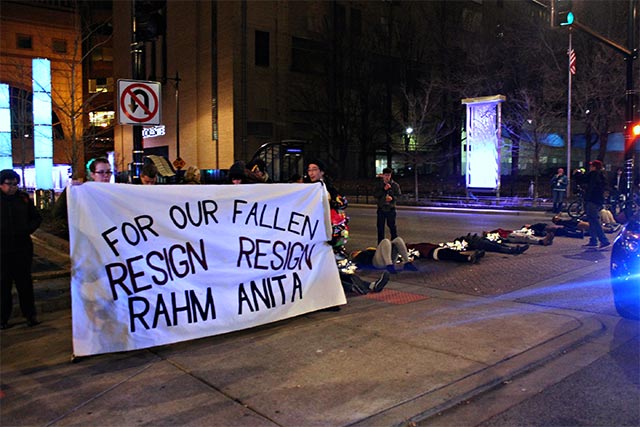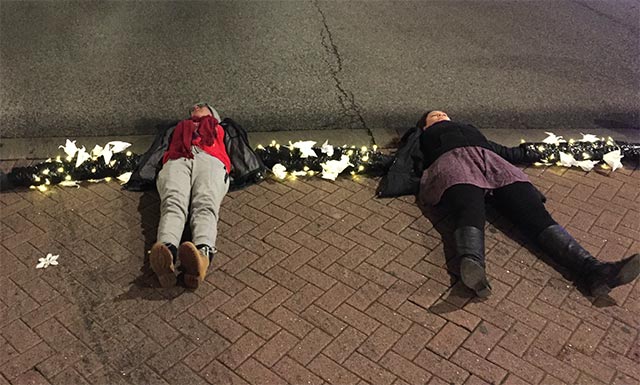
Toting a number of large gift-wrapped packages, a group of 16 Chicagoans walked into a crosswalk in the city’s financial district on December 15. After strolling into a formation that stretched from one side of Congress Parkway to the other, at the mouth of the Eisenhower Expressway, they unwrapped the packages, revealing a set of lockboxes – blockade devices that attach protesters to one another as they attempt to hold space – and locked themselves together. The lockboxes were unusually ornate, with white lights and paper and cloth flowers woven throughout their surface area. Once a box connected each person in two human blockade lines, the equipment was illuminated, and a disruptive vigil for Chicago’s fallen began.
I was one of those protesters.
There were 16 of us in total – representing the 16 shots that Chicago Police Officer Jason Van Dyke fired into the body of Laquan McDonald. Amongst the boxes that connected us, there was a shining light for each of the 475 people who had fallen to violence in Chicago in 2015. We stood in memory of Laquan McDonald and other victims like him, as a living symbol of the connectedness between Chicago’s corrupt, violent, racist police practices and the violence Chicagoans experience in our streets each day.
Starving and criminalizing our communities, Mayor Rahm Emanuel has spent the full duration of his time in office compounding the conditions that lead to crimes of poverty. In keeping with this indifference toward our most marginalized communities, Emanuel has also consistently offered a free hand to police who would harass and harm our city’s young people.
Unsurprisingly, this marriage of neglect and abuse has led to an increasingly dysfunctional environment in our city streets.
But as the public debates whether or not officials have been complicit in the cover-up of Laquan McDonald’s murder, few have dug deep enough to question the complicity of our city’s mayor, Rahm Emanuel, as well as Cook County State’s Attorney Anita Alvarez, in the violence that Chicagoans experience on a daily basis.
The criminalized, occupied and brutalized are not part of Mayor Rahm Emanuel’s Chicago.
Since 2012, The Chicago Light Brigade, an arts-focused community action group, has partnered with organizations like Project NIA to hold vigil for those our city has lost to violence, and to discuss what we can do to build community safety. These conversations usually focus on community-driven transformative action, as we have come to expect very little from our city’s leadership. While officials point fingers and echo tired refrains about family values and gun laws, the truth of what maintains the violent dynamics at work in our neighborhoods is so simple that those in power must avoid acknowledging it at all costs.
 (Photo: Kara Rodriguez)
(Photo: Kara Rodriguez)
In communities with plentiful resources, violence is uncommon. It is not brutal policing that keeps those places safe, but an overall regard for the people who live there. Needs are met. People are treated with dignity and respect in both policy and practice.
We live in two Chicagos. One that is furnished with such conditions, and one that is not.
But to cater to those who actually keep him in power, Mayor Emanuel has consistently robbed underserved communities of schools, services, clinics and hope. Prior to the recent scandal around dashcam footage of Laquan McDonald’s murder at the hands of a white police officer, Emanuel has backed those who have abused these communities at every turn. The criminalized, occupied and brutalized are not part of Emanuel’s Chicago, and when they have organized community police-watch efforts to protect themselves from state violence, Emanuel has blamed their organizers for making police less effective.
Like many officials around the country, Emanuel has invoked the myth of the so-called “Ferguson effect” to mask his own failures, and in so doing, provided political cover to police that operate as criminally as any organized crime syndicate.
By robbing our communities of essential resources and consistently backing a racist, brutal and incompetent police department, the mayor has ensured that, without forceful public intervention, the regular onslaught of violence in our city will continue. State’s Attorney Anita Alvarez has likewise reinforced these conditions by consistently failing to hold police criminally accountable for their actions, while zealously prosecuting those who commit actual crimes of survival.
Aimed at a literal intersection of our oppressions, the Memorial Blockade was a humanization of our connected struggles.
For these reasons, and out of love for those we’ve lost, we chose to take this year’s “For Our Fallen” vigil to the next level, by making our annual, artful moment of collective grief into a moment of collective resistance. The City of Chicago has long viewed any rejection of the status quo as a material threat. At last year’s vigil, police surrounded the group on all sides, even though it was, in its totality, a night of art, song and shared experience. This year, we chose to rise to the historic moment we are living in, wherein our city exists in an ongoing standoff with a mayor and a state’s attorney whose political machinations have made Chicago a less just and less safe place for the people who live, work and die here.
 (Photo: Kara Rodriguez)
(Photo: Kara Rodriguez)
Like much of the resistance work in our city during the last year, this action was led by women of color who regularly immerse themselves in the work of direct action. Working in partnership with The Chicago Light Brigade and Project NIA, the Black and Brown organizers of the direct action collective Lifted Voices organized the protest, bringing together a coalition of participants of various racial and socioeconomic backgrounds.
We put our bodies on the line to form a living, breathing memorial to those who could no longer stand on their own behalf, and to express our love for those struggling through this moment of fractured politics and scandal. We stood for them, and with them, before laying our bodies down in traffic, with hundreds of vehicles sprawled out around us. And for a moment, before Chicago’s brutal police lived up to their now nationally known reputation by attacking the vigil, we were what we had set out to be – a representation of a city raging against death, corruption and the violence being inflicted upon our communities.
As I waited for the police to reach my section of the vigil, I heard one officer laugh and announce that the vigil was “a joke” as officers shoved knives into our lockboxes, threatening to “accidentally” cut us as they removed us, one by one, from the blockade line.
We brought what light we could, if only for an hour, and experienced therein the kind of violence we have come to expect from Rahm Emanuel’s police force.
The location of the action, which seemed especially irksome to police, was not arbitrary, nor was it selected simply for the level of disruption we might cause there. As my fellow Lifted Voices organizer Crystal Vance Guerra explained:
[The blockade’s] location, at the intersection of Immigration and Customs Enforcement, the Metropolitan Correctional Center and the Chicago Stock Exchange, was an homage to the victims of the generalized state violence all our communities experience because of these three institutions.
Aimed at a literal intersection of our oppressions, the #MemorialBlockade, as it was dubbed on social media, was a humanization of our connected struggles.
Among those who took arrest that night was a young married couple. Ruby Pinto, an organizer with Lifted Voices, locked down with her life partner, who upon hearing our plan of action volunteered to put his body on the line alongside hers. As we stepped into the crosswalk, I was overwhelmed by the love they were bringing into the streets with us. As Ruby told me after the action, “to resist is an act of love,” adding that, “fighting alongside each other felt as natural as making a home and building a life together. It’s who we both need to be in this world.”
 (Photo: Monica Trinidad)
(Photo: Monica Trinidad)
As the police employed pain-inducing tactics to pry us from the vigil, I was already laying flat on the street. Locked to those next to me, there was nothing but the Chicago sky and the faces of hovering police officers within my eyeline as I heard the cries of protesters and the corresponding laughter of the SWAT team. Ruby and her partner stood their ground as long as anyone, and as they were forced into separate police vehicles, I knew that the state’s power paled in comparison to the love of two people who truly believe that it is their duty to love and protect one another.
The violence inflicted by police that night gave onlookers a representation of the times we are living in. And as they rallied in support, demanding that the violence cease, the character of our city’s police was once again dragged into the light, a reminder of why our city has been rocked with unceasing protests since the release of the dashcam video.
As we stretched out on cold asphalt, well aware of the violence that the police might, and did, unleash, we held tight to the ideals that had brought us there. We also stood firm in the hope that our efforts might generate enough bond funds to not only ensure our own freedom, but that of abuse survivor Naomi Freeman. Freeman, yet another Black woman failed by this system of injustice, was spending the holiday season in Cook County Jail, awaiting trial for the alleged killing of a man who for years had abused her, posing a threat to her very survival and the well-being of her children. Freeman, who is pregnant, was charged with the same crime as Officer Van Dyke, who shot down Laquan McDonald in cold blood. Freeman has been the subject of a community campaign aimed at securing her bond, and bringing her home to her family for the holidays.
By tying our bond fund to hers, and explaining that effort to donors on social media, we hoped that our action would not only make a statement about the injustice of our legal system, but also help to liberate a marginalized person who that system is poised to crush under its wheels.
So, working in concert with the Chicago Community Bond Fund, Love and Protect, and other organizations that address systemic injustice, we did our own small part to not only symbolically demand the freedom and safety of those who live under an abusive system, but to also make a literal, loving effort to free a Black woman from a cage. Because if we believe that Black and Brown people are being wrongly imprisoned and murdered en masse by the state, it is our duty to not only ideologically oppose those harms, but to take every stand that we can to empty the cages that hold them.
I say all of this, not in praise of my own actions, which I felt were much less brave than many others that night – including those who had never before endured arrest or experienced police brutality – but in awe of those I stood with, and of groups like Black Youth Project 100 (BYP) and Fearless Leading by the Youth (FLY), who have carried the torch of resistance in our city this year. As a number of BYP and FLY members rushed to our side to sing and chant alongside us that night, I could feel the air fill with their fierce love of our communities, and I could feel my fear of the police melt away in favor of the strength they imparted.
If this sounds like a love letter to my community, and to those who defend it, that’s because it is. In some ways, this action itself was a love letter, to everyone who has brought their energy and creativity to movements against state violence during the last year. They deserve as much, and we all deserve to live in a world where our dreams of freedom don’t simply hover in the distance, but actually electrify our streets in real time.
So today, as we stare down our respective court dates, facing charges for our actions that night, those of us who gather with our loved ones at this time of year will do so knowing that Naomi Freeman just might be able to do the same. And if Christmas finds Naomi with her mother and children, I hope we all feel well reminded of what’s possible when our communities build from a place of love.
For my part, I can safely say that whatever awaits me in that courtroom was well worth the effort, and the risk.
We took action that night in the hope of building the broken parts of our city, and ourselves, into the better world that we know is out there, waiting to be made real. And like many others, we don’t plan to relent until every last one of us is free.
Author’s note: Abuse survivor Naomi Freeman has been released on bond and will be spending the holidays with her family.
Join us in defending the truth before it’s too late
The future of independent journalism is uncertain, and the consequences of losing it are too grave to ignore. To ensure Truthout remains safe, strong, and free, we need to raise $46,000 in the next 7 days. Every dollar raised goes directly toward the costs of producing news you can trust.
Please give what you can — because by supporting us with a tax-deductible donation, you’re not just preserving a source of news, you’re helping to safeguard what’s left of our democracy.